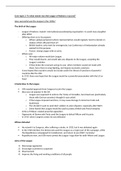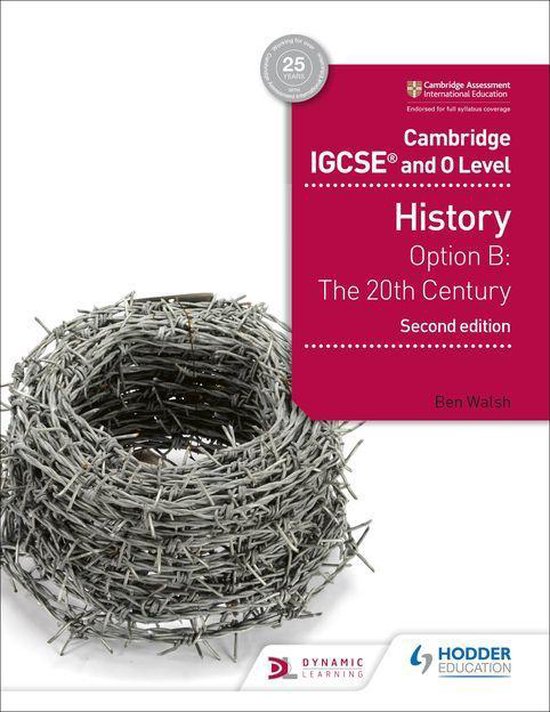Core topic 2: To what extent was the League of Nations a success?
How successful was the League in the 1920s?
The birth of the League
- League of Nations created- international peacekeeping organisation- to avoid mass slaughter
after WW1
- Differing views as to its purpose:
o Wilson: global parliament where representatives would regularly meet to decide on
matters which affected them all
o British leaders: only meet for emergencies, but Conference of Ambassadors already
existed for this purpose
o France: strong League with an army
- Wilson won
o All major nations would join League
o They would disarm, and would take any disputes to the League, accepting the
League’s solution
o If they broke the covenant and go to war, other members would not trade with
them, force them to stop fighting, and impose economic sanctions
- It was hoped that countries would not invade under the threat of sanctions of powerful
countries like the USA
- In 1919, there was hope that the League would be a powerful peacemaker with the US as
head
A body blow to the League
USA needed approval from Congress to join the League
Idea was not popular in the US:
o League was supposed to enforce the Treaty of Versailles, but Americans (particularly
those with German ancestry) thought it was unfair)
o If the League imposed sanctions, it may cause damage to American trade and
businesses
o The US didn’t want to send their soldiers to solve disputes- especially after WW1
o Some feared that League would be used to protect British and French empires
- Critics of Wilson created powerful opposition
- Opponents of Democratic Party used the League to defeat Wilson and his party
- In 1919, when Congress voted, he was defeated
Wilson defeated
He retook it to Congress, after suffering a stroke, in 1920, but it was defeated again
In the 1920 election, the Democrats used the League as a major part of the campaign, while
the Republicans campaigned for Isolationism, and return to pre-WW1 ‘normalcy’
Republicans won, and USA never joined the League- huge blow for both Wilson and League
Aims of the League
1) Discourage aggression
2) Encourage countries to cooperate
3) Disarmament
4) Improve the living and working conditions of all people
, Article 10: collective security
Membership of the League
- Britain and France most powerful
- Both countries were not ready to fill USA’s shoes- both were weakened by the war and had
few resources to fill USA gap
- US was only country which had resources or influence to make League work, particularly
trade sanctions
- Both countries had other priorities:
o British politicians: rebuild trade and look after empire
o France: concerned with Germany- League didn’t have army so couldn’t protect
France- it was ready to bypass the League in its own interests if it had to
Organisation of the League
The League of nations was made up of several organisations:
o The Council: a smaller group where most power lay- Britain and France were the de
facto leaders of the League- 4 permanent members (Britain, France, Italy, and
Japan), temporary members elected on 3-year periods. Each member had a veto
Range of powers:
Moral condemnation
Economic sanctions
Military force
o The Assembly: discusses issues with all countries, maximises representation
o The Secretariat: bureaucracy of the League, support behind the power
o The Permanent Court of International Justice (PCIJ): international court to solve legal
issues, e.g. border disputes- but it has no real power
o The International Labour Organisations (ILO): addressed point 4, solved international
worker disputes and brought together workers, employers, and governments
Did not have much power, but it campaigned strongly for a general
improvement in working conditions
Introduced a maximum 48-hour week and an 8-hour day, but only few
countries accepted
Poisonous white lead was banned from paint
Limited hours that children were allowed to work
The League of Nations had many commissions to tackle major problems:
o Mandates commission:
Mandates were former colonies of Germany + its allies, ruled by Britain or
France on behalf of League. It reported to the League how mandates were
being treated, and made sure Britain and France were acting in interest of
mandates, not themselves
o Refugees Committee:
After WW1, there were hundreds of thousands of refugees who fled from
conflict- some needed to get back home, others didn’t have homes
Most were former Russian territories
400 000 prisoners were returned by the League’s agencies
Always short of funds
o Slavery Commission:
Worked to abolish slavery around the world
East Africa was the biggest problem





